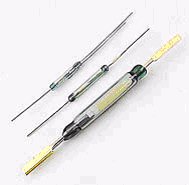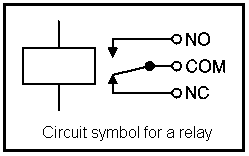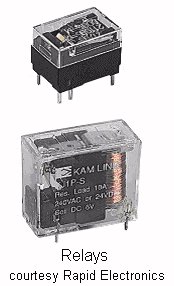Glossary R
RailCom
RailCom is the bidrectional (return) element of DCC, although not released at the same time as the main elements of DCC the bidirectional side was introduced in 2011. The susbsystem enables selected CV data held within the loco or accessory decoder to be transmitted back the the command station or in the case of loco DCC address to a local block detector. It was originally developed by Lenz the creates of DCC, and is now a RailCommunity standard RCN-217). Further development is in progress by European companies, and this extension is called RailComPlus (Auto-logon).
RailCom works by having the command-station/booster stop driving the rails between DCC packets and placing a short circuit across the track for approx. 470uS, during the inter-message idle packet and is known as the “cutout”, then the decoder generates a 30 mA serial encoded signal on to the track. The data output by the decoder can be in either Channel 1 or Channel 2 or both, Channel 1 is for the loco addresses that the decoder will respond to. Channel 1 data is unsolicited data 2 (6 bit) bytes in size called datagrams, that is to say the data is sent out without being requested and is received and decoded by “local” detectors around the layout in track “blocks”. Channel 2 data can be up to 6 bytes of 6 bit bytes and is only transmitted out by the decoder in response to a command sent to the decoder by the command station. This data is received and decoded by only one “global” detector on the system layout. Therefore the maximum data transmitted in the DCC cutout period for CH1 and CH2 is 8 bytes (datagrams).
An example of RailCom Channel 1 detectors are shown here railcom.
RailCom/Plus allows: the identification of unknown trains; block occupancy; transmission of train information, such as its actual speed; and more efficient 'on-the-main' programming. See: RailCommunity standard and ESU RailCom Plus.
RailCommunity
RailCommunity is a German organisation made up of primarily DCC decoder manufactures. Due to the fact that the NMRA (original custodians of the Lenz DCC standards) were not passing on the enhancements being made to the DCC system, then making their way into the documented standards at the rate required by decoder manufactures. Although the NMRA DCC standards are still active the RailCommunity orginisation was formed to bring the system enhancements and developments quicker so manufactures and customers alike were quicker informed.
Today the current standards are published by RailCommunity with close involvement with the NMRA, MOROP and BDEF. One slight disadvantage is that although the RailCommunity documents are always up to-date they are only published in the German language. Fortunately, Merg has these German documents translated into English and available for members to view here: DCC Standards
Raspberry Pi
RASPBERRY PI FOUNDATION provide low-cost, high-performance computers that people use to learn, solve problems and have fun.
Two current models of single board computer running LINUX based system with several development environments…
Pi Zero (aka Pi0) 1 GHz single-core CPU, 512 MB RAM, HDMI, USB and 40 pin GPIO (~ £4)
Pi 3 B (aka Pi3) 1.2 GHz quad-core CPU, 1 GB RAM, Ethernet, Wireless, Bluetooth, HDMI, 4 x USB and 40 pin GPIO (~ £35)
RC filter
A resistance and capacitor network to limit a particular frequency
Or noise rejection from motors
Rectification
The process of converting alternating current (AC) to direct current (DC). most offten using diodes. The diodes are commonly arranged in a set of 4 combined in one package. See also “Bridge rectifier”.
Reed Switch
The contacts of a reed switch (usually SPST) are closed by bringing a small magnet near the switch. They are used in security circuits, for example to check that doors are closed. Standard reed switches are SPST (simple on-off) but SPDT (changeover) versions are also available. Warning: reed switches have a glass body which is easily broken!

Regulated power supply
This is a typical simple regulator supply using an LM317Integrated circuit. Zener diodes can also be used to regulate low power to fixed levels.

Relays
A relay is an electrically operated switch. Current flowing through the coil of the relay creates a magnetic field which attracts a lever and changes the switch contacts. The coil current can be on or off so relays have two switch positions and they are double throw (changeover) switches.
Relays allow one circuit to switch a second circuit which can be completely separate from the first. For example a low voltage battery circuit can use a relay to switch a 230V AC mains circuit. There is no electrical connection inside the relay between the two circuits; the link is magnetic and mechanical.
The coil of a relay passes a relatively large current, typically 30mA for a 12V relay, but it can be as much as 100mA for relays designed to operate from lower voltages. Most ICs (chips) cannot provide this current and a transistor is usually used to amplify the small IC current to the larger value required for the relay coil. The maximum output current for the popular 555 timer IC is 200mA so these devices can supply relay coils directly without amplification.
Relays are usually SPDT or DPDT but they can have many more sets of switch contacts, for example relays with 4 sets of changeover contacts are readily available. For further information about switch contacts and the terms used to describe them please see the page on switches.
Most relays are designed for PCB mounting but you can solder wires directly to the pins providing you take care to avoid melting the plastic case of the relay.



Resistor
Resistor is the name for an electronic component exhibiting Resistance. Resistance is the property of a component which restricts the flow of electric current. Energy is used up as the voltage across the component drives the current through it and this energy appears as heat in the component. Resistance is measured in ohms, the symbol for ohm is an omega. 1ohm (written 1R0) is quite small for electronics so resistances are often given in 'k' (kilo) and M (meg). 1k = 1,000 (1k0); 1M = 1,000,000 (1M0). Resistors used in electronics can have resistances as low as 0.1ohm or as high as 10M.
Resistor network
A set of resistors combined in one package for convenience in assembling circuits. Often abbreviated to “Resnet”.

“Resnets” come in 3 basic package types. Pin at one end is common to all (odd number of pins). Individual resistors in single line, pair of pins for each resistor. Individual resistors in DIL, resistors connect to pins on opposite sides of package.
Resonator
A device used to produce an oscillation of a specific frequency, primarily for use as the clock signal for digital circuits.
Reverse polarity
The Positive voltage goes to the Negative part of a circuit and vice versa.
Used to reverse DC motors in trains.
RFC
Request for Comment is a way of making a suggestion for a change to some standard or way of working. It is used within MERG for discussion of changes to the CBUS protocol.
RFID
Radio Frequency IDentification
Wikipedia: RFID
MERG Demonstration
MERG RFID systems
The tags generally used in MERG RFID systems have a 40 bit ID number, that is 5 bytes, when transmitted there is then a sixth byte added which is a checksum for data integrity. The tag readers transmit the data over a serial link using ASCII Hex. The start of a message is STX <0x02> this is followed by the 12 ASCII Hex characters of the data plus checksum, some readers then send LF <0x0A> CR <0x0D>, and finally ETX <0x03>. This makes a message of either 14 or 16 bytes in total.
The MERG Concentrator replaces the STX with a reader identification letter, A to H or I to P. For CBUS the incoming data is converted back to its original 5 bytes and checked against the checksum. These 5 bytes are then transmitted as bytes 3 to 7 of an 8 byte message. <Opcode><DN/NN Hi><DN/NN Lo><data0><data1><data2><data3><data4>
Risk assessment
An analysis of the risks and the method of management in a strategy or practice.
RLSC
Reversed Linked Section Control is a method for the control of the switching of DC power to sections of track on a model railway layout. It is described in Technical Bulletin T32/1 of April 2002.
Also see here for articles on the subject.
RMS
Root Mean Square. This is what you read on an analogue meter used on AC voltage. It compares to the dc level. So it’s an average value.Wikipedia - RMS
Road Vehicle Control
Usually refers to a electronic system to control model road vehicles.
Route setting
This is used when you operate a set of instructions to drive a train from A»>B with all the instructions to operate points and signals.
RPC
Remote Panel Control. RPC System - Remote Panel Interface (RPI)
(RS232 Single Unit PC Interface Module) Includes PCB and all components a MERG system
Main article
RPI
Remote Panel Interface. RPC System - RPI.
Serial interface module for PC control. RS485 Multi-Drop version. Includes PCB and all components. a MERG system
Main article
RS232
It is commonly used in computer serial ports. Is a standard for serial binary data signals connecting between a DTE (Data terminal equipment) and a DCE (Data Circuit-terminating Equipment) RS232
RS485
It is commonly used in computer serial ports. RS485 enables the configuration of inexpensive local networks and multidrop communications links. It offers high data transmission speeds (35 Mbit/s up to 10 m and 100 kbit/s at 1200 m). Since it uses a differential balanced line over twisted pair (like EIA-422), it can span relatively large distances (up to 4000 feet or just over 1200 metres). RS485
RSA
The RSA is a RS 232 to RS485 converter a MERG system
RSE
RPC System - RSE (Remote Stack Extension)
Allows a stack of RPC modules to be divided into remotely located parts, connected using standard 4 pair Cat 5 network cables. Includes PCBs and all components. A MERG system
RTC
Computer controller train controller from the RPC collection a MERG system
RTFM
Read The Flipping Manual
RTOS
Real Time Operating System.